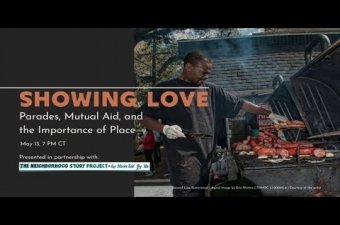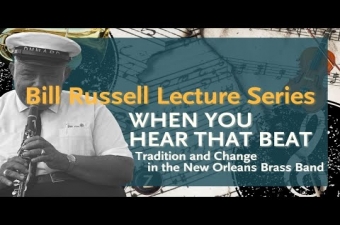
Benevolent Societies / Social Aid and Pleasure Clubs
The Role of Benevolent Societies and Social Aid and Pleasure Clubs in the Development of New Orleans Music
Benevolent societies and social aid and pleasure clubs (SAPCs)–two types of mutual aid organizations–have been some of New Orleans’ most important musical patrons since the 1800s, fostering the birth of jazz and sustaining New Orleans’ brass band tradition. Their sponsorship of these bands kept the foundational rhythms and rituals of New Orleans music accessible to successive generations of artists, who derived new forms from them throughout the 20th century.
Black communities established mutual aid organizations to provide for various needs, including medical and burial insurance, which mainstream institutions denied them because of their race. The first such groups in the city were benevolent societies operated in the early 1800s by free Creoles of color (or Afro Creoles), who occupied a social position between enslaved people and those not considered “colored.” Members paid dues to the organization, which then covered expenses related to health care and funerals. The groups also held social gatherings, with Creole musicians playing waltzes and other classical European forms.
After the Civil War, African Americans emancipated from slavery formed hundreds of new mutual aid groups in the city. Afro Creole benevolent societies with their own meeting halls often rented their facilities to these and other Black organizations, which had few other places to congregate. In this way, the society halls hosted an array of events featuring live music, including concerts, dances, and other stage performances.
Around the turn of the 20th century, the city and state enacted increasingly harsh segregation laws, imposing a single category of second-class citizenship on Creoles of color and African Americans. Musicians of both backgrounds, finding work and receptive audiences in benevolent society halls, came together and forged a new style of playing, later called jazz. Bandstands in places like Economy Hall became venues of cultural exchange between French-speaking Afro Creoles, who tended to be Catholic and influenced by European music, and English-speaking African Americans, who tended to be influenced by the music of Protestant churches and the blues.
Some African Americans recalled experiencing classist or colorist discrimination in elite society halls, but in the Jim Crow era the societies themselves became bases of political organizing meant to benefit all Black people—Homer Plessy, for example, whose challenge to segregation resulted in the 1896 U.S. Supreme Court ruling Plessy v. Ferguson, was an officer in La Société des Francs Amis, a prominent benevolent society.
Keeping Brass Bands in the Street
Benevolent societies and SAPCs, which emerged in parallel with them, conducted funeral rites for their members, often including a brass band procession. These organizations also conducted celebratory neighborhood parades called second lines, named for the line of people that trailed after the club and the brass bands they hired.
These bands, as William J. Schafer writes, proved to be “a major source, a gene pool,” for the development of jazz. Early jazz artists including Jelly Roll Morton, Sidney Bechet, Louis Armstrong, and Danny Barker left vivid accounts of formative encounters with brass band music in the streets. Barker also wrote about the collective rhythm of “society members dressed in new flashy sports outfits: fancy expensive silk shirts, new pants, hats, ties, socks…”.
European immigrants and their descendants established their own mutual aid associations in the late 19th and early 20th centuries, and most often hired white brass bands for their events. The musician and scholar Dr. Michael White writes in Dancing in the Streets that these bands waned in popularity after the 1920s, while “the Black New Orleans brass band tradition grew and further developed its distinctive sound” thanks to “continuous sponsorship” by Black organizations.
Though the Great Depression and the growth of Black insurance companies greatly reduced the viability of benevolent societies by the 1930s, SAPCs continued to pool resources for members and hold second lines on Sundays.
After World War II, as with the emergence of jazz decades earlier, New Orleans musicians drew on the sound of parade bands in ways that changed the course of popular music. Growing up on a second line route in Treme, drummer Earl Palmer had clapped along with brass bands on beats 2 and 4. In the 1940s and 50s he used the same emphasis as the “backbeat” he played on seminal records by Fats Domino and Little Richard, helping define the sound of rock ‘n’ roll. Other New Orleans drummers, from Smokey Johnson to Zigaboo Modeliste, brought the second line’s heavy bass drum and syncopated rhythms to the pop charts in the 60s, helping lay the foundation for funk music.
Feuling a Second Line Renaissance
By the late 1960s “the New Orleans sound” had again permeated the wider culture, but local interest in second lines was at a low ebb. Then, in 1968, civil rights leader Jerome Smith co-founded the Tambourine and Fan organization in Treme, which taught children the history and rituals of the tradition, raising consciousness of it as a source of community uplift and pride. Tambourine and Fan started the Bucketmen Social Aid and Pleasure Club and an affiliated youth brass band, and several participants later became stalwarts of new SAPCs and brass bands.
In the early 1970s, SAPCs were among the first patrons to provide steady work for the Fairview Baptist Church Christian Marching Band, a group assembled by parade aficionado Danny Barker. The Fairview band provided musical and professional training to a wave of musicians, mostly in their teens, who went on to start their own brass or traditional jazz bands; many also became music teachers, mentors, and scholars of the culture. They proved to be the leading edge of a citywide brass band renaissance.
In the late 70s, popular demand by SAPCs led to a transformative residency for the Dirty Dozen Brass band at a barroom called The Glass House. Trumpeter Gregory Davis, one of several Fairview band alumni to co-found the Dirty Dozen, told author Karen Celestan, “the different clubs…would start showing up on Monday just to dance to what we were playing, and we realized we had an opportunity then to…experiment with some music.” The Dirty Dozen introduced be-bop, R&B, and other influences into their playing, and the SAPC members danced their approval, their moves pushing the band’s tempo. The new style took off across the city.
In the 1980s and 90s the Rebirth Brass Band built on the Dirty Dozen’s innovations, and parlayed their popularity with SAPCs to become a New Orleans institution. The band became favorites at second lines by playing nonstop medleys, with tuba player Philip Frazier hitting bass riffs over and over, like a sample in a hip hop song, while the front-line horns played melodies familiar from the radio. Club members’ dancing, sometimes called buckjumping, reached new heights, and second lines surged in popularity, with new brass bands and SAPCs filling up the city’s Sunday parade calendar. Rebirth’s modern second line style has been a major influence on New Orleans music ever since, from bounce to the funk/rock that artists like Trombone Shorty take to festivals around the country.
Leading a Post-Katrina Revival
While SAPCs had always worked on behalf of their communities—events like school supply and holiday meal giveaways remain common—they stepped into a greater public role in the wake of Hurricane Katrina in 2005. Four months after the levees failed, with the city considering a plan not to rebuild some Black neighborhoods, a coalition of 29 clubs held a massive second line in Treme that rallied support for displaced families’ right to return. It was a symbolic gesture, but not an empty one. A 2010 study by sociologist Frederick Weil found that SAPC members were the most “civically engaged” segment of the post-Katrina population, a quality correlated with stronger community recovery.
In the post-Katrina era, with roughly 95,000 Black residents permanently exiled from New Orleans proper, SAPCs continue to parade on their traditional routes, keeping brass bands on the streets for the next generation.
Videos

"Showing Love: Parades, Mutual Aid, and the Importance of Place" from the Historic New Orleans Collection presented in partnership with the Neighborhood Story Project in 2021.
Video by The Historic New Orleans Collection.
"Showing Love: Parades, Mutual Aid, and the Importance of Place" from the Historic New Orleans Collection presented in partnership with the Neighborhood Story Project in 2021.

"When You Hear That Beat: Tradition and Change in the New Orleans Brass Band" from the Historic New Orleans Collection in 2021.
Video by The Historic New Orleans Collection.
"When You Hear That Beat: Tradition and Change in the New Orleans Brass Band" from the Historic New Orleans Collection in 2021.
Images

















